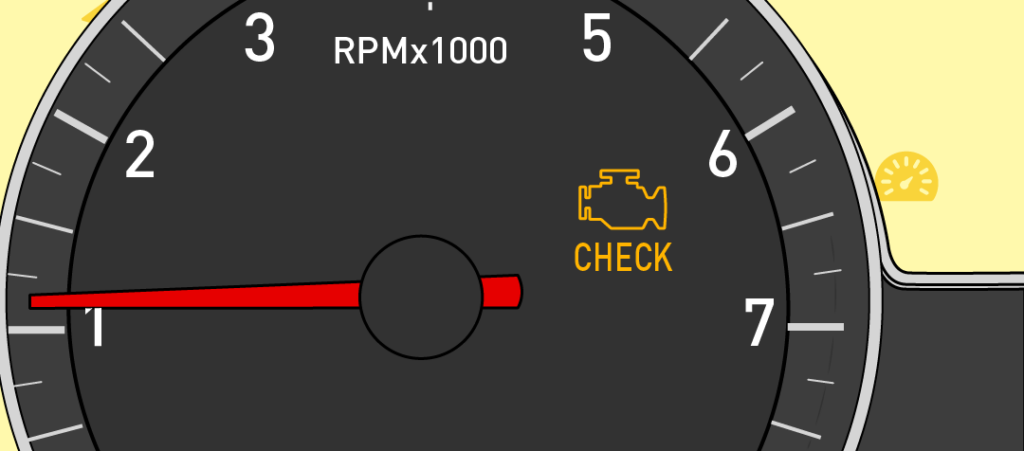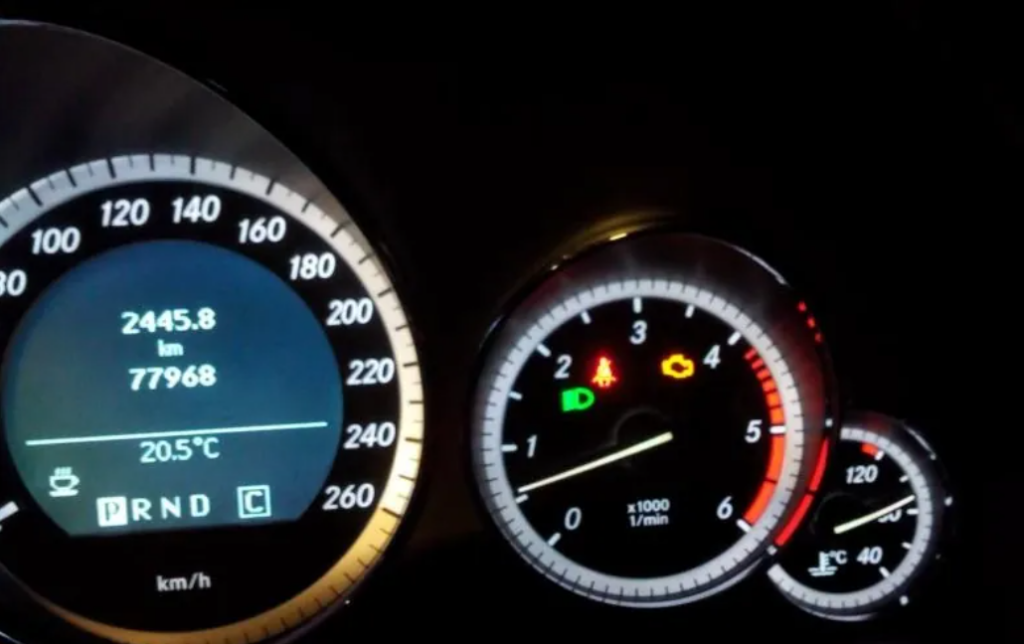Table of Contents
Check Engine Light is Flashing: Causes, Diagnosis & Mercedes-Benz Case Study
The check engine light (CEL) is one of the most misunderstood dashboard warnings. Unlike straightforward alerts such as “low oil” or “door open,” the check engine light can represent dozens of possible problems from a simple loose gas cap to severe engine misfires.
When the light is steady, the issue is often less urgent but should still be addressed soon. When it is flashing, it signals a serious fault that requires immediate action. Ignoring it can damage expensive components like the catalytic converter or even the engine itself.
In this guide, we’ll explain what the check engine light means, why it turns on, what to do when it flashes, and share a real-world Mercedes-Benz E-Class case study where a flashing engine light was traced to a defective oil pump solenoid.
This article is part of our Mercedes Check Engine Light – Complete Troubleshooting Hub, where you’ll find detailed case studies and repair guides.

What the Check Engine Light Means
- – Steady light → non-critical fault (sensor issue, emissions problem, etc.).
- – Flashing light → severe fault (engine misfire, ignition failure, catalytic converter risk).
When the light flashes, the ECU (engine control unit) is detecting ongoing combustion or emissions problems that could rapidly escalate into costly repairs.

Common Causes of the Check Engine Light
| Cause | Typical Symptoms | Quick Fix |
|---|---|---|
| Engine misfire | Rough idle, vibration, flashing CEL | Replace faulty coil, spark plug, or injector |
| Ignition system fault | Hesitation, poor acceleration | Replace spark plugs/ignition coils |
| Fuel system issue | Hard starts, poor fuel economy | Test and replace injector/pump as needed |
| Exhaust system failure | Failed emissions, rotten egg smell | Repair/replace catalytic converter |
| Mass Air Flow (MAF) sensor fault | Stalling, poor throttle response | Clean or replace MAF sensor |
| Loose/damaged gas cap | Light on, no performance impact | Tighten or replace cap |
What To Do If the Check Engine Light Comes On
Immediate Steps
- 1. Check for obvious signs – Look for smoke, strange smells, or unusual noises.
- 2. Reduce load – Ease off the throttle and avoid high RPM driving.
- 3. Find a safe spot – Pull over safely if the light is flashing.
- 4. Check fluids – Verify oil and coolant levels are not low.
- 5. Scan for codes – Use an OBD-II scanner to retrieve error codes.
- 6. Consult the manual – Your owner’s manual may explain specific CEL behavior.
- 7. Seek professional help – Visit a qualified mechanic or dealership if unsure.
Warning: Driving with a flashing CEL is unsafe. Stop immediately and arrange diagnosis.

Case Study: Flashing Check Engine Light on Mercedes E-Class (W212, M274 Engine)
The Situation
A loyal customer brought in his Mercedes-Benz E-Class W212 with the M274 gasoline engine after seeing the check engine light flashing. He noticed no major noises, but the warning made him anxious.

Diagnostic Process
- 1. Read fault codes with Mercedes STAR/XENTRY.
- 2. Error stored in ECU: oil pump solenoid valve fault.
- 3. Technician verified electrical supply and solenoid resistance.
- 4. Confirmed the oil pump solenoid was defective.



Repair Steps
- 1. Replaced the oil pump solenoid valve with OEM part.
- 2. Reset ECU fault memory.
- 3. Performed test run under different load conditions.
Result: The engine ran smoothly, CEL turned off, and the issue was fully resolved.
Understanding the Oil Pump Solenoid Valve
The oil pump solenoid is responsible for regulating oil pump pressure in response to engine demand and temperature. A failure can cause:
- – Oil flow disruption
- – Higher friction in moving components
- – ECU triggering a CEL due to incorrect pressure signals
Timely replacement restores correct lubrication and protects the engine from long-term wear.

Symptom – Cause – Fix Table
| Symptom | Cause | Recommended Fix |
|---|---|---|
| CEL flashing under load | Misfire or ignition fault | Replace coil, plug, or injector |
| CEL steady + poor fuel economy | Faulty O₂ or MAF sensor | Replace sensor |
| CEL steady + reduced power | Catalytic converter fault | Replace catalytic converter |
| CEL flashing + oil-related code | Oil pump solenoid failure | Replace solenoid |
| CEL on after refueling | Loose gas cap | Tighten/replace cap |
Does the Check Engine Light Come On for Oil Changes?
Typically, no. The check engine light does not exist to signal routine oil changes. Instead, many vehicles (including Mercedes-Benz) use a maintenance reminder light for oil changes.
However, if low-quality oil or lubrication faults (like the defective solenoid in our case study) are detected, the ECU may trigger the CEL to protect the engine.
FAQs
Q: Can I drive with the check engine light flashing?
No. A flashing CEL indicates an urgent problem, such as a misfire or lubrication issue. Stop driving immediately.
Q: How much does it cost to fix a check engine light problem in a Mercedes?
It depends. A loose gas cap may cost $20. A faulty catalytic converter can cost $1,500+. Accurate diagnosis is key.
Q: Can low oil cause the check engine light to come on?
Yes. If oil pressure is too low or lubrication control components fail, the ECU may trigger the CEL.
Q: What diagnostic tool should I use?
For Mercedes, STAR/XENTRY is best. However, a reliable OBD-II scanner can provide generic codes.
Safety Tips During Repairs
- – Let the engine cool down before inspection.
- – Always use OEM replacement parts (coils, solenoids, sensors).
- – Wear protective gloves and glasses when checking fluids or wiring.
- – If unsure, seek professional service DIY errors can worsen the problem.
Conclusion
The check engine light is more than just a vague warning it’s your vehicle’s way of demanding attention. While sometimes caused by minor faults, it can also point to serious failures, as seen in the Mercedes-Benz E-Class W212 case study, where a defective oil pump solenoid triggered the light.
Understanding the difference between a steady and flashing CEL, knowing common causes, and following a structured diagnostic process will help you react appropriately. Prompt attention not only saves costly repairs but also keeps your Mercedes running at peak performance.
Author Bio
Written by Mercedes Expert
With years of hands-on experience diagnosing and repairing Mercedes-Benz systems, he brings technical depth and practical case studies to help car owners, technicians, and enthusiasts troubleshoot complex automotive issues. His work focuses on clear repair guides, OEM-level procedures, and knowledge-sharing to empower both professionals and drivers.
Last update: September 2025






Leave a Reply